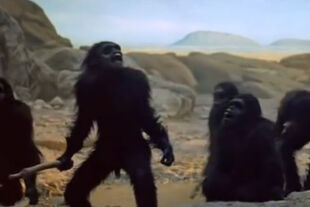 |
| Moon-Watcher and his tribe from the film. Source |
Chapter 4:"The Leopard"
The narrator goes through the various tools that the man-apes learn how to use after killing the warthog with a stone in the previous chapter: the hand-held stone, the bone club, the lower jawbone of an antelope, a gazelle horn, and a whole jaw. These tools are used to hit, cut, or scrape.
The man-apes of Moon-Watcher's tribe have made vast improvements since learning how to use tools. They can now hunt larger animals, have more leisure time, and start to think in more advanced ways. They almost ignore the monolith still by the river and almost forget their former way of life.
There are two problems still plaguing the man-apes, though: there's the leopard and the Others.
One day, the tribe heads back to the cave, not landing a single kill all day. Along the trail they notice an antelope with a broken leg on the ground, and a pack of jackals surrounding it. When they see the man-apes arrive, the jackals retreat. Once the man-apes surround the antelope, they run toward the creature with their weapons. After killing the antelope, the sun is setting in the sky, and the jackals return to the area. Moon-Watcher begins dragging the corpse toward the cave with the others helping him. Once in the cave, the tribe feasts on the meal.
That night, Moon-Watcher wakes up after hearing a pebble drop. He looks down the steep slope and sees the leopard's eyes looking right at him. The leopard reaches the top of the slope, following the blood trail from the antelope, and enters the cave. The man-apes attack the leopard with their tools until it runs out of the cave and falls down the cliff.
The next morning, the leopard is found dead at the bottom of the slope. The man-apes use their bone knives and saws and eat the carcass, and they do not hunt that day.
Chapter 5: "Encounter in the Dawn"
Moon-Watcher and his tribe go to the river in the morning. Along the way, Moon-Watcher pauses at the spot where the monolith once stood. It is no longer there, and he no longer remembers it being there.
The Others are there at the other side of the river, as per usual, but something is different today. They notice Moon-Watcher and the rest looking more menacing than normal with their tools in hand. The Others begin their screaming and chanting, but soon are frozen in fear when Moon-Watcher holds up a stick with the leopard's head impaled on it. With one swoop, Moon-Watcher kills the leader of the Others, One-Ear, with the fangs of the leopard.
Chapter 6: "Ascent of Man"
This chapter serves as a time skip that covers the evolution from man-apes to humans. The man-apes do not invent anything new for one hundred thousand years after the monoliths had descended on Africa. Interesting to note here is that the author refers to the monolith in the plural sense, so there were more than one that landed on Earth.
The physiology of the man-apes begin to change. Their large teeth grow smaller since they no longer use them, as per the "use it or lose it" rule. Their snout becomes flatter and the first sounds of speech begin to take shape.
Four Ice Ages pass by over thousands of years, killing off life that cannot adapt, including the man-apes. Those that do survive, however, have evolved. Their hands have developed the ability to create better tools, which allows their bodies and brains to develop further. And finally, humans, Homo sapiens, have appeared on Earth.
Humans' ability to speak allows them to pass on knowledge from one generation to another through oral tradition. Once humans learn how to control fire, they no longer behave strictly like animals. Different materials to make tools emerge, like bronze and iron. Agriculture develops. Social communities grow bigger from tribes to villages to towns. Written language is developed. Philosophy and religion emerge. Humans invent more weapons: spears, bows, guns, and missiles.
Humans have conquered the world, and they develop new tools that can help or hinder their survival. But as long as their weapons exist, their existence hangs in the balance.

No comments:
Post a Comment